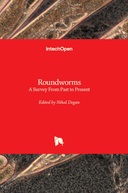Explore

The first roundworm identified in humans was Ascaris, described by Linnaeus in 1758. Rudolphi’s 1808 classification was the first to describe the Nematoidea. With the development of new molecular techniques, classification and phylogenetic research have also frequently changed; in 2019 a new classification, the phylum Nematoda, was created based on evolutionary relationships, developmental and morphological features and recent molecular evidence. Nematodes, which include hookworms, whipworms, threadworms, and soil-borne worms, are one of the oldest disease-causing creatures, dating back to Ancient Greek, Roman and Mesopotamian civilizations. Most commonly affecting children and women, the disease causes developmental disorders, cognitive impairment and death, with symptoms primarily affecting the organs they inhabit. In this book, the historical background, biology, transmission routes and geographical distribution of some roundworms affecting human health are discussed.
This book is included in DOAB.
Why read this book? Have your say.
You must be logged in to comment.
Rights Information
Are you the author or publisher of this work? If so, you can claim it as yours by registering as an Unglue.it rights holder.Downloads
This work has been downloaded 86 times via unglue.it ebook links.
- 46 - pdf (CC BY) at Unglue.it.
- 40 - pdf (CC BY) at mts.intechopen.com.
Keywords
- Clinical & internal medicine
- Diseases & disorders
- Helminthiasis
- Infectious & contagious diseases
- Investigation
- Lymphatic filariasis
- medicine
- Parasites
- Pathogenesis
- thema EDItEUR::M Medicine and Nursing::MJ Clinical and internal medicine::MJC Diseases and disorders::MJCJ Infectious and contagious diseases
Links
DOI: 10.5772/intechopen.102153Editions

